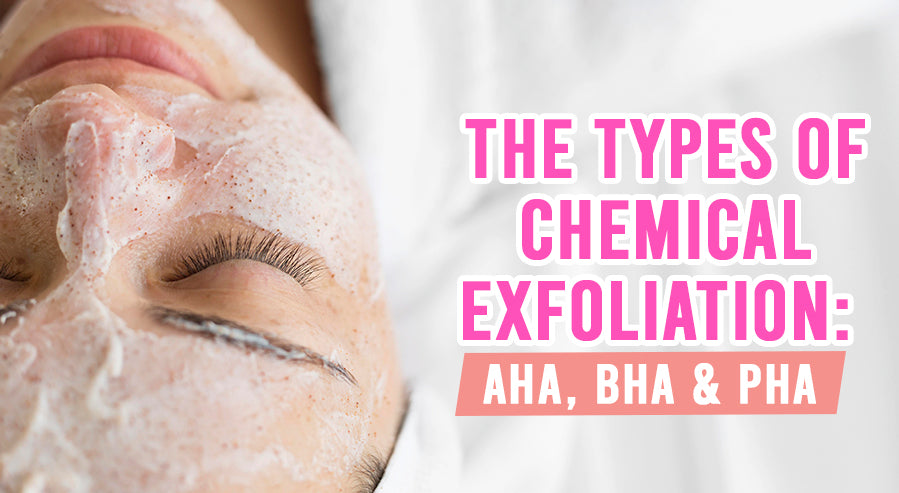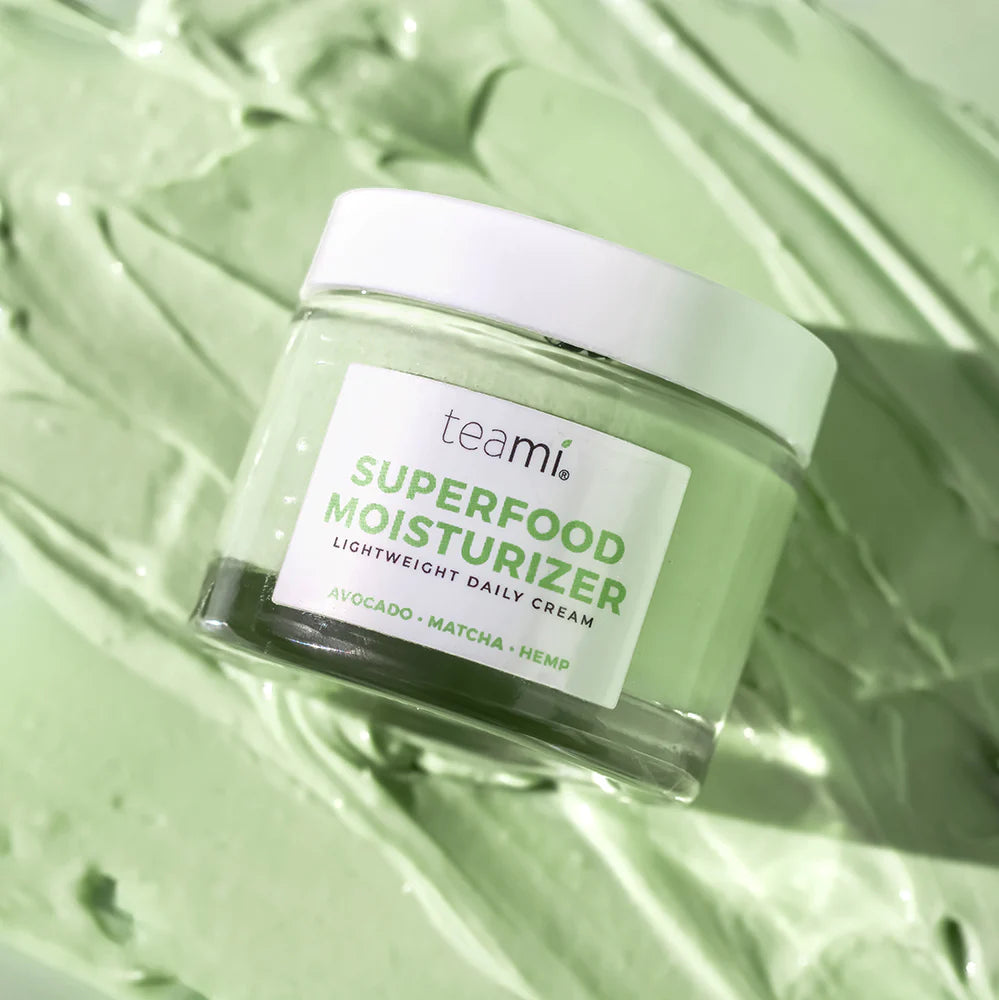The Types of Chemical Exfoliation: AHA, BHA & PHA

Navigating the world of skincare can be like being in a simple science class, especially when you are searching for that sparkling skin. The biggest headache often comes from trying to understand the different kinds of acids you encounter. Terms like AHA, BHA, and PHA might make you feel more than a little confused.
These short names stand for alpha-hydroxy acids (AHAs), beta-hydroxy acids (BHAs), and polyhydroxy acids (PHAs). Though these terms might be hard to understand, they're basic tools to help you get that glowing skin. However, the differences between them may need a bit of explanation.
This guide is here to make these acids easier to understand and to make the whole process simpler. The main goal is to help you pick the right acid for your skin type without feeling lost. So, let's walk through gardens filled with AHA-rich products, and let's dive into the mysteries of Vitamin B.
By the way, these "acids" are not as scary as they might seem. All in all, understanding them is somewhat easier than you'd think. Trust me, with a little patience, choosing the right acid for your skin will become pretty easy. Yeah, the skincare world might be complex, but with the right tools, it's quite manageable. Fair enough, right?
Understanding AHA, BHA, and PHA
So, AHAs, BHAs, and PHAs are the three main acids used in skincare to improve your skin's appearance. It's kind of like your skin has its very own cleaning squad - each member has its special way of boosting how your skin looks.
AHAs, coming from different plant sources or milk, work on the surface of your skin. These parts that dissolve in water remove old cells from the top layer of your skin, making it look fresh and shiny while triggering collagen creation for more solid-looking skin. You might notice glycolic acid, which is one usual kind of AHA, on product labels.

The next helper in our cleaning group is BHAs. These parts that dissolve in oil are different from AHAs as they go deeper into the skin pores to get rid of excess oil and dirt, leading to a cleaner-looking face. Salicylic acid is an example of a BHA, and it's known for its power against acne because of its ability to fight bacteria.
In the end, we find PHAs. No way can we forget them as they're like nicer family members to AHAs - they bring similar pluses but with less chance of annoying your skin due to their bigger size, which stops them from going too deep into the skin. Believe it or not, these parts also do great at keeping the skin wet from the inside, which makes them perfect for sensitive or dry skin.
Molecular Structure: The Key Differentiator
All three types act differently because of their unique, tiny structures. This determines where they work within our skin's complex layers and how they do their job. You see, AHAs are small. They can slip easily between broken, old cells on the surface of the skin. This helps remove those cells faster and shows the fresher skin below. On the contrary, BHAs can go deeper due to their love for oil and cleaning out blocked pores.

PHAs, however, work more gently than AHAs due to their bigger structure. This makes them pretty easy to use for people with delicate skin or those who are new to using chemicals for skin care. After all, these products have a lot to do with how our skin looks and feels. All in all, it's important to understand their differences. We need to keep them in mind when choosing which one to use. To put it simply, we should select the type that would be more beneficial for our skin condition, don't you think?
A Breakdown of AHA
If you want bright and glowing skin, AHAs or alpha hydroxy acids can be your go-to tools. Basically, AHAs help get rid of old and dull skin cells, which allows your skin to produce more collagen and get that glowing look.
The great thing about these widely used skin care ingredients is that they can help to remove unneeded old skin cells. Common AHAs are glycolic acid and lactic acid, which come from things as simple as sugar cane and milk.
Glycolic acid, thanks to its small size, can get deep into your skin. It's really good at handling problems like small wrinkles, acne, blackheads, dullness, and oily skin. Want to get the hang of glycolic acid? You can learn about it here.
Lactic acid not only helps to lighten dark spots but also gives dry or older skin a moisture boost. Unlike glycolic acid, it is gentler, which makes it a good pick for those with sensitive skin. You can discover more about the good things lactic acid can do here.

Let's not forget AHAs don't just come from synthetic sources. Citric acid (from citrus fruits), malic acid (from apples), and tartaric acid (from grapes) offer similar benefits and also provide antioxidants.
For a fresh look, citric acid as an AHA removes dead cells from your face. Believe it or not, it is also a strong antioxidant that protects from harmful free radicals.
Tartaric Acid, which is packed with antioxidants as an AHA, helps keep the pH levels steady while offering gentle peeling that results in brighter skin.
On a side note, malic acid is another milder option. It provides a slow and steady exfoliation, which is a good fit for those having sensitive skin or conditions like rosacea.
It turns out AHAs not only smooth the skin but also push collagen production, which is a protein that keeps your skin looking young and refreshed. After all, glowing and vibrant skin could be just a few steps away.
A Breakdown of BHA
Oil-dissolving acids that are good for your skin are called Beta Hydroxy Acids, or BHAs for short. You probably know one type of these acids: salicylic acid. Salicylic acid is made out of willow bark and sweet birch trees, and it's really good at killing bacteria.
You see, the cool part about these BHAs is how they work. They go deep into your skin to find the cause of any problem. Kind of like detectives on a secret mission! They're really good at getting rid of acne and making sun-damaged skin look better by unclogging pores.
Are you having a hard time with skin problems, like acne that won't go away or blackheads that just won't pop out? Well, BHAs might be the solution you're looking for!
These acids are great because they bring down the redness that comes with breakouts, and their bacteria-killing skills help keep zits from popping up. They clean out your pores, seriously improving your skin.

Using these regularly does more than just get rid of pimples; it improves your overall skin health in the long run. Perhaps you've got some sun damage, or maybe your skin tone looks off when you see yourself in the mirror. That's where salicylic acid comes in. It brings back the glow on dull skin.
To get the best out of these acids without any side effects, choose a product that fits your needs and how you use it. Be sure to check that the concentration levels of BHA (0.5% - 2%) match your skin sensitivity and how often you use it.
Remember, BHAs aren't a one-size-fits-all cure; what works for one person won't necessarily work for another. When it comes to skincare products, things can get somewhat tricky. Don't be bummed out if the first product you try doesn't work. Yeah, it might take a little trying and testing, but believe it or not, great skin is totally worth the effort!
A Breakdown of PHA
In this piece, we're going to talk about PHAs, which are large and help with gentle skin cleaning. They're great for sensitive skin because they keep it moist and lower swelling.
We'll look at how PHAs can help those with sensitive skin and issues like eczema and rosacea.
You may think skincare only involves harsh chemicals that make your skin raw and annoyed. However, you need to think again. The world of beauty has grown, and how we care for our skin needs to change as well.

Here come PHAs - polyhydroxy acids. They are champions in caring for sensitive or allergy-prone skin. They are so large that they stay on the top layer of your skin, not moving deep inside. This gives a slow effect that doesn't upset sensitive skin.
Their ability to keep skin moist stops any dryness, giving your face a nice glow all day. You should get help from a skin doctor for guidance that suits you. Since they fight off harmful things, these strong molecules shield against harmful things in the environment. They are great buddies for city folks who deal with dirty air every day.
Research shows that people with eczema saw major improvement after using products with PHA for over four weeks. Another good point? Even though these acids stay on top layers without going deeper into pores like AHA/BHA, they still draw out dirt trapped inside by pulling it toward their large structure.
Guess what? No more worrying about upsetting your sensitive skin while getting the benefits of skin cleaning. Truly, this is a perfect solution.
AHA vs. BHA vs. PHA: The Differences
AHAs, BHAs, and PHAs are the three main products for skin care. Each one works in its own way with different skin types because of how different they are in size and how they work. To summarize:
- AHAs have really small parts, small enough to go deep into the skin. This helps boost the production of collagen and reduce wrinkles.
- Then we have BHAs, also known as beta-hydroxy acids. Now, these are a bit different; they can mix with oils and have slightly larger parts, allowing them to go deeper into the skin pores and clean them out.
- PHAs, which stand for polyhydroxy acids, have even bigger parts. This makes them gentler because they only really work on the very outer skin layer.
Sure, each of these acids peel off the dead skin by breaking the connections between dead cells at different levels due to their different parts. AHAs are basically working at the surface level of the skin to give you that fresh glow. But BHAs? They go further in dealing with hard-to-get-rid-of issues like acne or blackheads.

If you've got dry or aged skin, you're likely to find help in AHAs because of how well they moisturize. People with oily skin or those prone to acne might find BHAs useful thanks to their power to clean deeply inside the pores and thus stop breakouts.
PHAs are for those who are asking for a gentle but effective way of peeling off dead skin, especially if their skin is sensitive. This link gives a deeper look into how PHAs can help you.
Lastly, whatever your unique skin needs are, always test new products on a small spot of your skin before going all in with their use. With these three great options available, we're now definitely in a good position to get that shiny skin we've always wanted.
Incorporating AHA, BHA, and PHA into Your Skincare Routine
Adding AHA, BHA, and PHA into your skincare routine can totally change the look and feel of your skin. However, picking the right acid that matches your skin type is so important.
Acids you know as AHAs, like glycolic or lactic acid, mix well with water. These are perfect for those of us with skin that is dry or damaged by the sunlight. AHAs pull double duty: they bring back hydration, and they gently scrape off dead skin cells.
If you're just starting to use AHAs in your skincare routine, you'd think it would be a good idea to stick with products that don't have a high level of acid. Not being careful can lead to irritation.
Using these regularly could seriously make your fine lines less visible because the acids cause your skin to produce more collagen. Believe it or not, that's your ticket to a youthful glow!

On the other hand, BHAs like salicylic acid do well with oil. They can actually go deep into pores that are blocked up. This makes them an actual lifesaver if you have skin that breaks out a lot. These particular acids also work to possibly soothe the redness that comes along with breakouts.
Blackheads won't know what hit them! If you're like most people and get an occasional pimple that just seems to stick around, BHAs could be what you need. One exfoliating peel actually contains both AHAs and BHA, along with PHA. It might just be the skincare multitasker you've been looking for.
Give Your Skin The Care It Deserves
We've dug deep into the world of AHA, BHA, and PHA. Yes, those are kind of complicated skincare words, but we've broken them down into smaller, more understandable parts, like how we found out that AHAs boost collagen to make your skin glow and reduce dark spots.
Also, we didn't just skim the surface for BHAs. We learned about their skill at getting deep into your skin to clean out pores and help fix skin damaged by the sun. Then, we found out that PHAs are great for gently scrubbing off dead skin. They're perfect for those with sensitive skin due to their big molecular structure.
With this information, you're set to make smarter decisions about your skincare routine. No more guessing what those labels mean. Now, you can pick products based on what's right for your own skin! And you bet we all know looking after our skin can't just be about choosing the right acid.
Believe it or not, with AHA, BHA, and PHA in our toolbox, glowing skin is possible for everyone!

You could try our Bright Dark Spot Serum if you need to get rid of dark spots, dark skin patches, acne scars, or dullness. We have something else, too - the Hibiscus Infused Vitamin C Serum! To get the most out of these serums, put them on every day, in the morning and at night. But hang on, there's one last step. You have to "seal" in the good stuff from these serums by using your moisturizer. This combo works wonders! Trust me, the extra moisture from the serum will make your skin look like it's healthy, hydrated, and rested.
Subscribe to our Newsletter
Subscribe to our newsletter and get 10% off your first purchase
 Instagram
Instagram



